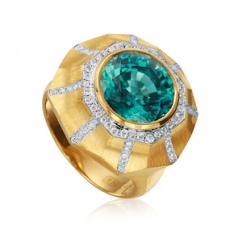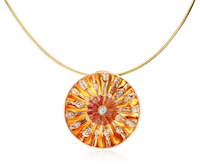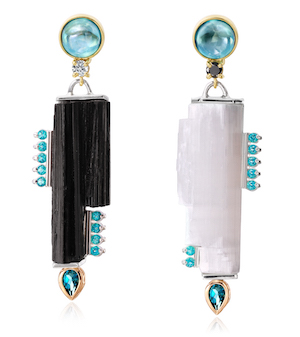Articles and News
Industry News: JA Names Retailer CASE Award Winners; All GIA Clients Must Comply With New ID Rules May 01, 2019 (0 comments)

JA Announces Retailer CASE Award Winners
New York, NY – Jewelers of America (JA), announces the winners of its 29th annual CASE Awards jewelry design competition to recognize JA retail members’ jewelry designs. (Left: Ricardo Basta won first place in two categories. This ring, in the $2,001-$5,000 retail price category, was one.)
First and second place winners were selected out of 54 entries in four retail price categories: up to $2,000, $2,001 to $5,000, $5,001 to $10,000, and $10,001 & over.
Winners were determined by a panel of design experts who evaluated the entries on the following criteria: overall design, marketability, practicality/wearability and quality of manufacture. Judges this year were Brecken Branstrator, National Jeweler; Amy Elliott, JCK contributor and All That Glitters columnist; Deirdre Featherstone, Featherstone Design; Amanda Gizzi, Jewelers of America; JB Jones, NYC Jewelry Week; Erica Silverglide, GemologyGeek; and Maria Tsangaropoulos, GIA Jewelry Manufacturing Arts instructor.
The winners were:
- Jewelry Up to $2,000: first place, C3 Designs, South Milwaukee, WI; second place, The Gem Vault, Flemington, NJ.
- Jewelry $2,001 to $5,000: first place, Ricardo Basta Fine Jewelry, Los Angeles, CA; second place, Devon Fine Jewelry, Wyckoff, NJ.
- Jewelry $5,001 to $10,000: first place, Lee Ayers Jewelers, Stevens Point, WI; second place, Bella Fine Jewelry LLC, Guilderland, NY.
- Jewelry $10,001 & Over: first place, Ricardo Basta Fine Jewelry; second place, Faye Kim Fine Jewelry, Westport, CT.


From left, winners in the under $2,000, $5,001 to $10,000, and over $10,000 price categories.
“The CASE Awards shine a spotlight on the custom designs of the talented jewelers in Jewelers of America Member stores across the country,” says JA president and CEO, David J. Bonaparte. “We are excited to offer a national platform to recognize the creativity and fine craftsmanship of these JA Members.” All first and second place winners will receive a customized CASE Award trophy and national and local media coverage.
The 2019 CASE Awards were sponsored by Synchrony and Jewelers Mutual Insurance Group. The CASE Awards is open only to employees of JA Retail Member companies. For more information about the competition, detailed descriptions of each winning piece, and to view the full gallery of winners including second place pieces, visit www.jewelers.org/caseawards or call (800) 223-0673.
GIA Announces Improved ‘Know Your Customer’ Program; All Clients Must Comply
Carlsbad, CA—To comply with applicable laws, regulations, and best practices, GIA (Gemological Institute of America) is enhancing its ‘Know Your Customer’ program. All new and current laboratory clients will be required to confirm the identity and ownership of their businesses, and to provide identifying information for all authorized representatives conducting business with GIA on their behalf. These requirements are recognized globally and are not unique to GIA.
“GIA will only conduct business with reputable customers, suppliers and other third parties involved in legitimate business activities whose funds are derived from legitimate sources,” said Elizabeth Keating, GIA’s chief ethics and compliance officer. “As a global Institute, we have a responsibility to make all reasonable efforts to determine the true identity and ownership of client accounts, their source of funds, and the nature of their business. This is a global best practice.”
Beginning May 1, GIA will start to contact current laboratory clients with an invitation to update their personal and business information, provide required documentation, and to sign and submit a digital client agreement. Current clients may contact their client service representative with any questions or to begin the process. Learn more about the documentation requirements and process by visiting GIA.edu/opening-a-lab-account or contacting GIA.
All information provided to GIA by new or current clients will be used solely in relation to their business with GIA and will remain private and confidential in accordance with applicable laws and contracts. Required information includes, but is not limited to, valid government-issued photo identification, full legal name, date of birth, permanent address for each authorized representative, and disclosure of authorized third-party representatives. Client Agreements are available in several languages and can be previewed at GIA.edu/gem-lab-client-agreement.
Separately, GIA research scientist Dr. Karen Smit is lead author of a Science magazine article that shows how diamond research gives clues to the formation of the continents. Researchers examined tiny mineral remnants trapped in diamonds during the formation of the earth, and the results were published Monday in Science magazine, in the article “Sulfur Isotopes in Diamonds Reveal Differences in Continent Construction.” In addition to Karen Smit, fellow authors include Steven B. Shirey and the late Erik H. Hauri of the Department of Terrestrial Magnetism of the Carnegie Institution for Science; and Richard A. Stern, a research scientist at the University of Alberta in Canada.
“Diamonds are one of the most valuable gems, not only as jewelry but also in geoscience,” said Smit. “The mineral inclusions in diamonds let us study the inaccessible depths of Earth – somewhere that today’s science cannot otherwise reach.”
The researchers examined diamonds from the Zimmi mining area near the Liberia-Sierra Leone border, known for producing yellow diamonds. The Zimmi diamonds are classified as Type Ib diamonds because they have rare nitrogen impurities. Type Ib diamonds are exceptionally rare in nature, accounting for less than 0.1% of natural diamonds mined worldwide. By laser-cutting and polishing very thin plates from the Zimmi diamonds, the researchers were able to isolate and study sulphide inclusions, extracting chemical isotopes that offered clues to when the diamonds—and the deepest and oldest parts of the continents—formed.
“This kind of insight is possible only because of the unique characteristics of diamonds,” said Dr. Wuyi Wang, GIA vice president of research and development. “GIA’s significant investment in research, unique access to rare diamonds and the outstanding collaboration with the Carnegie Institution and the University of Alberta made this significant discovery possible.”
A summary of the Science article is available here.








